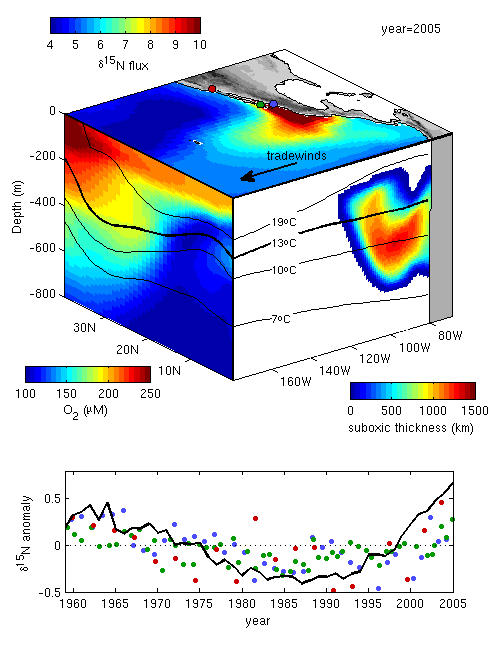Date:
Location:
Speaker: Dr. Curtis Deutsch, University of Washington-Seattle

Abstract:
The microbially mediated loss of bioavailable nitrogen (N) from anoxic marine environments plays a central role in the feedbacks that regulate the oceanic N cycle over time, and thus underlies one of the few known examples of planetary homeostasis. Although modern anoxic zones occupy a very small volumes of the ocean, their physical circulations are subtle, and their microbial metabolisms diverse, so the biogeochemical dynamics of these regions are still not well understood. I will present two recent results from high-fidelity models of the largest anoxic zone, in the tropical Pacific Ocean, that illustrate the ecological and climate dynamics driving N loss. First, in a new microbial ecosystem model we find that rates of N loss undergo large fluctuations even in a steady circulation. The variable N removal arises from ecological oscillations at the oxic-anoxic boundary, driven by resource competition between aerobes and anaerobes. Because the ecosystem oscillation lacks spatial coherence and power at interannual and longer timescales, it is unlikely to generate large-scale decadal variations in N-loss. To examine N loss variability at those time scales, we reconstruct past changes in N loss over the anthropocene using a combination of models simulations, historical climate observations, and the recent sedimentary record. Models predict that whereas a warming-induced reduction in gas solubility and a slowing of ocean circulation act in concert to deoxygenate the mid- and high-latitudes, these processes tend to counteract one another in the tropics. In the Pacific Ocean, oxygen demand rather than supply appears to be the dominant control on the scale of the tropical anoxic zones. However changes in oxygen demand are closely linked to the strength of the tropical trade winds and upwelling, providing a mechanism for transient contraction of anoxia even while climate warming deoxygenates the ocean. Taken together, these results suggest that interannual and shorter fluctuations in N loss are governed by microbial ecosystem dynamics, while decadal and slower modulation is provided by climate, via the tropical wind-driven circulations.